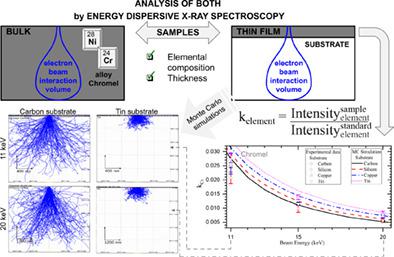当前位置:
X-MOL 学术
›
Microsc. Res. Tech.
›
论文详情
Our official English website, www.x-mol.net, welcomes your
feedback! (Note: you will need to create a separate account there.)
Determination of the composition and thickness of chromel and alumel thin films on different substrates by quantitative energy dispersive spectroscopy analysis
Microscopy Research and Technique ( IF 2.0 ) Pub Date : 2021-08-26 , DOI: 10.1002/jemt.23917 Raissa Lima de Oblitas 1 , Fernanda de Sá Teixeira 1 , Maria Cecília Salvadori 1
Microscopy Research and Technique ( IF 2.0 ) Pub Date : 2021-08-26 , DOI: 10.1002/jemt.23917 Raissa Lima de Oblitas 1 , Fernanda de Sá Teixeira 1 , Maria Cecília Salvadori 1
Affiliation

|
Thin films of two alloys (chromel and alumel), with thickness less than 100 nm, were obtained by plasma deposition technique, namely filtered cathodic vacuum arc (FCVA). The elemental analyses were performed by quantitative energy dispersive spectroscopy (EDS) microanalysis and Rutherford backscattering spectrometry (RBS). The applicability of EDS to such thin films as these was established by analysis of films deposited on substrates of different atomic numbers, specifically vitreous carbon, silicon, copper, and tin. We found that a substrate with atomic number similar to the mean atomic number of the film constituents is best for reliable EDS results, when compared to RBS. The compatibility between quantitative EDS measurements and RBS measurements, as well as comparison between the thin film elemental composition and the bulk material composition, was assessed by statistical analysis. Good consistency between EDS and RBS measurements was found for both chromel and alumel thin films when copper was used as substrate material. We observed severely overlapping peaks in the RBS output for the case of alumel films so that EDS analysis was crucial. We also compared thickness measurements determined by EDS and RBS, and we found good agreement for the case of alumel film on copper substrate, and 15% agreement for chromel film on copper substrate.
中文翻译:

定量能量色散光谱分析法测定不同基材上铬镍合金和铝矾土薄膜的组成和厚度
采用等离子沉积技术,即过滤阴极真空电弧(FCVA),获得厚度小于 100 nm 的两种合金(铬镍合金和铝镍合金)薄膜。通过定量能量色散光谱(EDS)微量分析和卢瑟福背散射光谱(RBS)进行元素分析。通过分析沉积在不同原子序数衬底上的薄膜,特别是玻璃碳、硅、铜和锡,确定了 EDS 对此类薄膜的适用性。我们发现,与 RBS 相比,原子序数与薄膜成分的平均原子序数相似的基材最适合获得可靠的 EDS 结果。定量 EDS 测量和 RBS 测量之间的兼容性,以及薄膜元素组成和块状材料组成之间的比较,通过统计分析进行评估。当使用铜作为基底材料时,铬镍合金和铝镍合金薄膜的 EDS 和 RBS 测量结果具有良好的一致性。对于铝膜,我们观察到 RBS 输出中出现严重重叠的峰,因此 EDS 分析至关重要。我们还比较了由 EDS 和 RBS 确定的厚度测量值,我们发现铜基板上的铝箔膜的一致性很好,铜基板上的铬镍膜的一致性为 15%。对于铝膜,我们观察到 RBS 输出中出现严重重叠的峰,因此 EDS 分析至关重要。我们还比较了由 EDS 和 RBS 确定的厚度测量值,我们发现铜基板上的铝箔膜的一致性很好,铜基板上的铬镍膜的一致性为 15%。对于铝膜,我们观察到 RBS 输出中出现严重重叠的峰,因此 EDS 分析至关重要。我们还比较了由 EDS 和 RBS 确定的厚度测量值,我们发现铜基板上的铝箔膜的一致性很好,铜基板上的铬镍膜的一致性为 15%。
更新日期:2021-08-26
中文翻译:

定量能量色散光谱分析法测定不同基材上铬镍合金和铝矾土薄膜的组成和厚度
采用等离子沉积技术,即过滤阴极真空电弧(FCVA),获得厚度小于 100 nm 的两种合金(铬镍合金和铝镍合金)薄膜。通过定量能量色散光谱(EDS)微量分析和卢瑟福背散射光谱(RBS)进行元素分析。通过分析沉积在不同原子序数衬底上的薄膜,特别是玻璃碳、硅、铜和锡,确定了 EDS 对此类薄膜的适用性。我们发现,与 RBS 相比,原子序数与薄膜成分的平均原子序数相似的基材最适合获得可靠的 EDS 结果。定量 EDS 测量和 RBS 测量之间的兼容性,以及薄膜元素组成和块状材料组成之间的比较,通过统计分析进行评估。当使用铜作为基底材料时,铬镍合金和铝镍合金薄膜的 EDS 和 RBS 测量结果具有良好的一致性。对于铝膜,我们观察到 RBS 输出中出现严重重叠的峰,因此 EDS 分析至关重要。我们还比较了由 EDS 和 RBS 确定的厚度测量值,我们发现铜基板上的铝箔膜的一致性很好,铜基板上的铬镍膜的一致性为 15%。对于铝膜,我们观察到 RBS 输出中出现严重重叠的峰,因此 EDS 分析至关重要。我们还比较了由 EDS 和 RBS 确定的厚度测量值,我们发现铜基板上的铝箔膜的一致性很好,铜基板上的铬镍膜的一致性为 15%。对于铝膜,我们观察到 RBS 输出中出现严重重叠的峰,因此 EDS 分析至关重要。我们还比较了由 EDS 和 RBS 确定的厚度测量值,我们发现铜基板上的铝箔膜的一致性很好,铜基板上的铬镍膜的一致性为 15%。











































 京公网安备 11010802027423号
京公网安备 11010802027423号